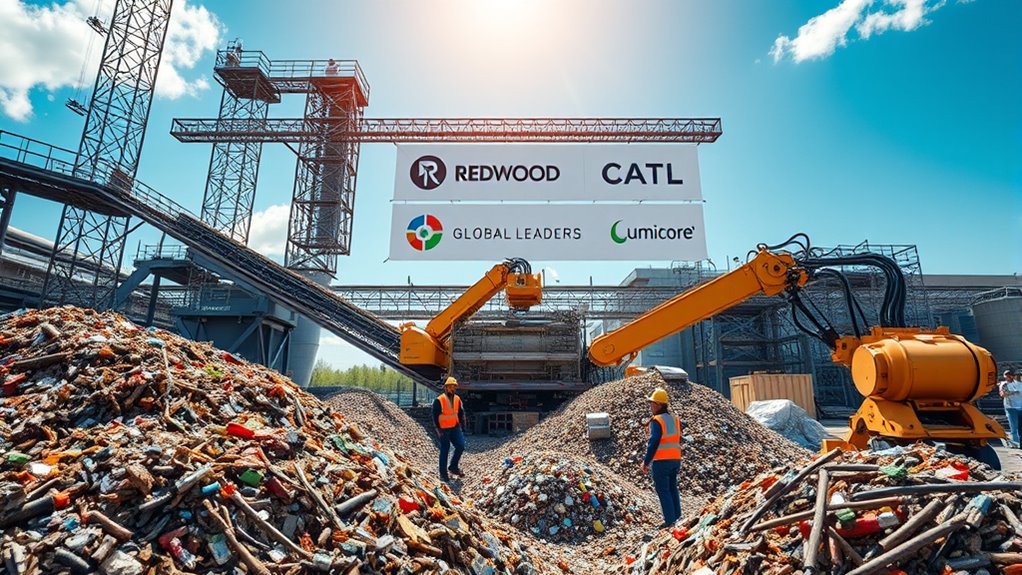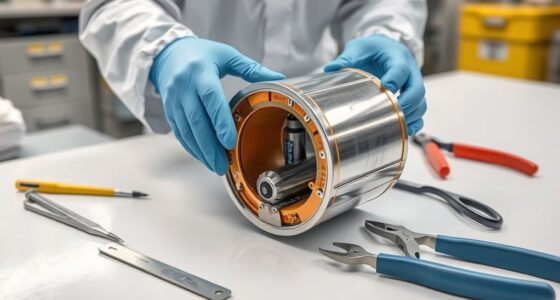Leading global recycling players like Redwood, CATL, and Umicore are transforming the way we recover valuable materials from used batteries. They develop innovative processes to extract critical metals such as lithium, cobalt, and rare earth elements, helping to reduce environmental impact and reliance on new resources. These companies are key drivers of a sustainable, circular economy in the battery industry. Continuing forward will give you a clearer picture of how they’re shaping the future of clean transportation.
Key Takeaways
- Major global EV battery recycling companies include Redwood Materials, CATL, Umicore, and Li-Cycle.
- These players focus on recovering critical materials like lithium, cobalt, nickel, and rare earth metals.
- Industry leaders are adopting innovative, environmentally friendly recycling technologies to promote a circular economy.
- Companies aim to reduce reliance on mining, lower environmental impact, and stabilize supply chains.
- The sector is rapidly evolving with increasing investments and technological advancements to support sustainable mobility.

Recycling has become a critical part of global sustainability efforts, and several key players are driving this movement forward. Among these, companies focusing on electric vehicle battery recycling are leading the charge, especially in the realm of rare earth metals recovery. As electric vehicles become more popular, the need to efficiently recycle batteries and recover valuable materials has never been greater. You might not realize it, but when you recycle EV batteries, you’re helping to conserve scarce resources and reduce environmental harm. Companies like Umicore have developed advanced processes to extract critical materials from used batteries, making sure that rare earth metals aren’t wasted. This approach not only minimizes the demand for mining new resources but also cuts down on the energy and carbon footprint associated with extraction. Such efforts are vital because rare earth metals are essential for many high-tech applications, including electric motors, wind turbines, and electronics, yet they are finite and often difficult to source sustainably.
Redwood Materials exemplifies how innovation in electric vehicle battery recycling is transforming the industry. Founded by a former Tesla engineer, Redwood has built a closed-loop system that takes used batteries and efficiently reclaims valuable components. Their process ensures that materials like lithium, cobalt, and nickel are recovered for reuse, significantly reducing the need to extract new raw materials. This not only helps stabilize supply chains but also diminishes environmental impact. Redwood’s approach exemplifies how recycling can create a sustainable lifecycle for batteries, which is crucial as the EV market expands rapidly.
Meanwhile, CATL, one of the world’s largest battery manufacturers, emphasizes the importance of integrating recycling into their production cycle. They invest heavily in developing technologies that allow for the seamless recovery of rare earth metals and other critical materials from spent batteries. By doing so, CATL aims to create a circular economy within the battery industry, decreasing reliance on mining and lowering costs. Their efforts showcase how major players are taking responsibility for the entire lifecycle of their products, ensuring that recycling and resource recovery are embedded in their business models.
Together, these companies illustrate the transformative potential of electric vehicle battery recycling and rare earth metals recovery. You can see that the future of sustainable mobility depends heavily on innovation in recycling technologies, efficient resource recovery, and proactive industry leadership. As more companies adopt these practices, the global impact will be profound—reducing environmental harm, conserving resources, and supporting the continued growth of clean transportation.
Frequently Asked Questions
How Do Recycling Companies Ensure Data Security During Electronic Waste Processing?
You guarantee data security during e-waste processing by using data encryption to protect sensitive information throughout the recycling process. Additionally, you implement secure data destruction methods, such as shredding or degaussing, to completely erase all data from devices before recycling. These practices prevent data breaches, safeguarding personal and corporate information, and ensure compliance with privacy laws, giving you confidence that your electronic waste is handled responsibly and securely.
What Are the Main Challenges Faced by Recycling Firms in Developing Countries?
Imagine steering a tangled maze of informal sector activities, where outdated infrastructure hampers progress. You face challenges like limited technology, poor facilities, and weak regulations that hinder effective recycling. Developing countries struggle with infrastructure development, making it tough to process e-waste efficiently and safely. Without proper systems, you risk environmental damage and health hazards. Overcoming these hurdles requires investment, policy support, and stronger collaboration to turn chaos into a sustainable recycling solution.
How Do Recycling Companies Innovate to Improve Material Recovery Efficiency?
You can improve material recovery efficiency by adopting innovative techniques driven by technological advancements. Embracing the circular economy encourages you to develop smarter sorting methods, automation, and advanced recycling processes that maximize resource reuse. By integrating these innovations, you reduce waste, lower costs, and boost recovery rates. Staying ahead in technology enables you to optimize operations and contribute more effectively to sustainable practices, ultimately enhancing your company’s impact on the environment.
What Role Do Government Policies Play in Shaping Recycling Industry Growth?
Your industry’s growth hinges on government policies, which can be as powerful as a tidal wave. Policy incentives motivate companies to innovate and invest in recycling, while strict regulatory compliance ensures sustainable practices. When governments prioritize recycling through subsidies or mandates, you’re encouraged to develop better technologies and expand capacity. These policies shape market dynamics, making recycling more effective and essential for environmental and economic success.
How Do Recyclers Handle Hazardous Materials in Complex Electronic Waste?
You handle hazardous materials in electronic waste by following strict safety protocols and using specialized equipment. First, you identify hazardous components like batteries and toxic chemicals. Then, you carefully dismantle devices, ensuring hazardous materials are separated and contained properly. You also comply with regulations to prevent environmental contamination and protect workers. Proper disposal or recycling of these hazardous materials is essential to minimize health and ecological risks associated with electronic waste.
Conclusion
As you follow these global recycling players like Redwood, CATL, and Umicore, it’s no coincidence that their paths are crossing at the forefront of sustainable innovation. Together, they’re shaping a future where waste transforms into wealth, and environmental impact diminishes. Keep an eye on these trailblazers—because what starts as a coincidence today might soon be the industry’s game-changer tomorrow. The recycling revolution isn’t just happening; it’s happening around you.









